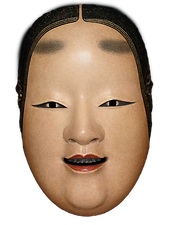
Nonomiya: From Village Lady to Spirit — Costumes and Masks
Story Background: Nonomiya is set in the sacred bamboo grove of Nonomiya Shrine, where Lady Rokujo, a noblewoman from the Heian court, experiences unfulfilled love and spiritual longing. The play explores attachment, impermanence (mujō), and the tension between worldly emotion and spiritual transcendence. The Shite appears first as a village lady, then later as the ghost of Lady Rokujo, while the Waki (traveling monk) and Ai (villager) provide grounding and narrative contrast.

前シテ / Maeshite
— 里女 / Village Lady
Mask

Waka-onna
若女
Fukai Ko-omote
深井小面

Emotional Expression: The mask’s gentle features and slightly downturned eyes convey softness, delicacy, and restrained emotion, setting a poignant tone for the Shite’s later ghostly form.
Costume: Karaori (brocade kimono) with uroko-haku (scale-pattern underrobe)
Emotional Expression: The elegant brocade and layered textures communicate feminine grace, purity, and gentle sentiment. Props such as the fan and autumn leaves accentuate gestures, visualizing inner warmth and reminiscence.
Hair: Kazura wig with Kazura-obi
Emotional Expression: The high-class wig emphasizes nobility, elegance, and refined poise.

後シテ / Nochishite — Spirit of Lady Rokujo
Mask: Waka-onna
Emotional Expression: The ghost mask expresses calm sorrow and lingering attachment; eyes and mouth convey quiet resentment and emotional tension.
Costume: Naga-kinu (long robe) with Hi-ōkuchi (deep red large hakama)
Emotional Expression: Deep red symbolizes jealousy, unresolved desire, and emotional intensity; the layered robes enhance the presence and gravitas of the ghost.
Hair: Kazura wig with Kazura-obi and Hiramotoyui
Emotional Expression: The hair and tying technique allow elegant, expressive movement; the fan becomes the primary instrument for expressing the ghost’s inner emotional fluctuations.


ワキ / Waki
— Traveling Monk 旅僧
Costume: Kakubōshi (priest hat), Mizugoromo (outer robe), and plain Noshi-me (simple robe)
Emotional Expression: The minimal color palette and simple design signify spiritual detachment and purity, providing contrast to the Shite’s intense emotions.

アイ / Ai
— Sagano Villager 嵯峨野の者
Costume: Chōjōge (long upper and lower garments)
Emotional Expression: Simple, muted attire conveys everyday realism and lightheartedness, offering narrative relief and emphasizing the Shite’s heightened emotional presence.





